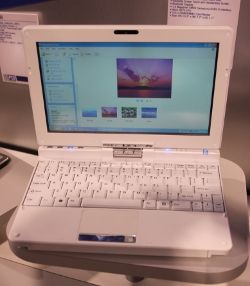Hands-On With PCD's X220 Touchscreen Netbook

Personal Communications Devices (PCD for short) isn't exactly a known player in the computing space. But, this week at CES, the company launched the X220, its first netbook. This 10-inch machine has the kind of flawed design and outdated specs that remind us of those early netbooks we saw back in 2008. Nonetheless, the X200, which PCD says will cost "under $400" unlocked, does offer some unique features, including a capacative touch display, support for both GSM and CDMA mobile broadband, and, best of all, a six-cell battery that lies flat and doesn't make the system heftier than it needs to be. Read on for what I liked-- and didn't-- about this underdog netbook.
Design
If I sound like I'm giving the X220 a hard time, it's mostly because of the design. The way I feel about the X220 is kind of how I feel about the Nokia Booklet 3G, another latecomer to the netbook market that tried to distinguish itself by offering optional mobile broadband: netbooks have been around too long at this point for companies to continue making elementary mistakes, like settling for a cramped keyboard or a single, stiff touch button. In fact, the X220's keyboard is sturdier than many, but it has the kind of small, but closely grouped keys that long ago gave netbooks' a bad rap for ergonomics. On the plus side, the touchpad has a smooth, low-friction surface.
Now that I've gotten the snark out of my system, here are a few things I do like about the design. One, the matte surface, which has the logo of Chinese manufacturer Haier printed on it, feels smooth and doesn't pick up fingerprints. Two, the metal hinge that attaches the convertible touchscreen to the chassis is a stylish touch, and makes the netbook feel durable (some tablets' weakness is that they feel unsturdy once you fold the screen over or rotate it).
Lastly, you can't tell by looking at the X220 that is has a six-cell battery. That's a good thing: whereas many netbooks' six-cell batteries either jut out of the back or create a bump on the bottom, the X220's lies completely flat, and is flush with the system. Netbook giants (is that an oxymoron?): take note.
Touch Experience
The X220 has a capacative touchscreen and also includes handwriting recognition software. However, it's important to note that PCD will be selling the netbook with either Windows 7 Starter or XP; the latter does not support capacative touch gestures. And, unfortunately, the unit that PCD has on display at CES is running XP. So, I can't comment right now on capacative gestures, such as swiping through photos, but I can say that even when it came to simple things like tapping icons, the display felt more like a resistive screen than a capacative one. We had to apply more pressure than we would have liked, a common complaint about resistive touchscreens, the kind you find on ATMs and the like. There were times when we tapped too lightly and the screen just didn't register our touch.
Stay in the know with Laptop Mag
Get our in-depth reviews, helpful tips, great deals, and the biggest news stories delivered to your inbox.
Specs
The X220's specs are an awkward mix of outdated and ahead-of-its-time. First, there's the fact that it will still be available with XP. Second, while most of the netbooks announced this week contain the latest version of Intel's Atom processor, dubbed Pine Trail, the X220 has a first-generation 1.6-GHz N270 CPU. It has a 160GB hard drive (there's also a 320GB option) and 1GB of RAM, which is fairly standard, although more miniature systems now have 250GB hard drives. PCD wouldn't comment on how many hours the six-cell battery should last.
Despite seeming a step behind when it comes to the basics, though, the X220 takes a unique approach to mobile broadband, supporting not just GSM networks (e.g. AT&T, T-Mobile), but CDMA ones, too. Meaning, in theory, you could bring this unlocked device to a Verizon or Sprint.
Early Thoughts
It's hard not to dismiss a netbook when it offers an uncomfortable keyboard and touchpad-- things we can't avoid using-- but I do, at least, appreciate that the PCD X220 promises more comprehensive support for mobile broadband than other netbooks. Perhaps if and when we test it we'll find the capacative touchscreen works smoothly with Windows 7, and that the battery life is long, both of which would help make up for the tepid ergonomic experience. Until then, we think the netbook veterans offer a closer-to-perfect package.
